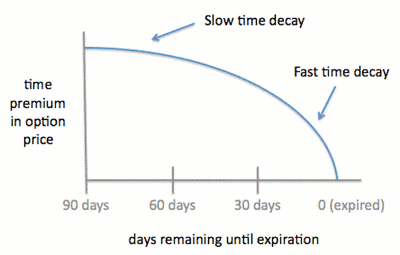Option writers must select the most favorable expiration date in order to maximize the amount of premium they receive. Here are the key factors that must be considered when choosing which options to sell.
All options lose value as time passes. They are a wasting asset and will decay over time. Covered call writers have a decision to make as to which expiration date to write. Is it better to write near-term options and take advantage of rapid time decay, or write longer-term options to reduce transaction frequency (and costs) and get more downside protection? The answer is "it depends"; let's take a look.
Non-Linear Time Decay
Time decay is defined as "a reduction in an option's price caused by the passage of time. It normally accelerates as an option nears its expiration date."
Graphically, we can view time decay this way:
The steeper the blue line, the faster the time decay. Each day that passes causes a small amount of time premium to disappear, until there is none left when the option expires. This erosion of time premium is the source of a covered call writer's income.
Annualized Rate of Return Is Higher on Short-Term Options
Because of the rapid decay during an option's final 30 days of life, many option sellers prefer to write short-term options. If one is merely interested in maximizing time premium per day that you collect, then the near-term option will be the option to write because the annualized rates of return will be higher than the longer-dated options.
However, if you are dealing with a low-volatility underlying stock, then the near-term option may not offer enough time premium to make the trade worthwhile after transaction costs. You may have no choice but to write an option that goes out two, three, or even six months in order to get enough premium to get a decent return after commissions.
Investors who have core holdings of non-volatile stocks will often do this-write out of the money options that have three to six months of time to expiration. Because the options are out of the money, they leave themselves some upside potential, and because the options have several months before expiration, the premiums are more than enough to cover the transaction costs.
NEXT: Downside Protection and Tax Implications
|pagebreak|Increased Protection
Another reason to write options farther out than the near month is downside protection. The more time you sell, the more premium you will receive. A two-month option will give you more premium than a one-month option, which increases your downside protection.
If you believe the underlying is at risk of decreasing in value over the next few months, you may be better off selling a two- or three-month option instead of a near-month option (or, possibly just sell the underlying and wait until you think you have a bullish case before getting back in).
If you are going to hold the underlying stock across some anticipated volatility event (like earnings), then you may be better off writing an option that has more premium in it than the near-month option as a defensive measure. The increased premium gives you a bit more protection, at the expense of a lower annualized rate of return.
Taxes
There may also be tax reasons to write options that go farther out. For example, by selling an option that expires in January of next year instead of one that expires in December of this year, you may be able to delay any tax event resulting from an option exercise until next year.
Note that this is a tricky area, though. If you sell options that are deep in the money, then the IRS may take the position that it was a constructive sale at the time you sold the option (as opposed to the time it was exercised). Of course, if you're doing covered calls in a non-taxable account (like an IRA), you can ignore these tax issues.
By Mike Scanlin of BornToSell.com






















